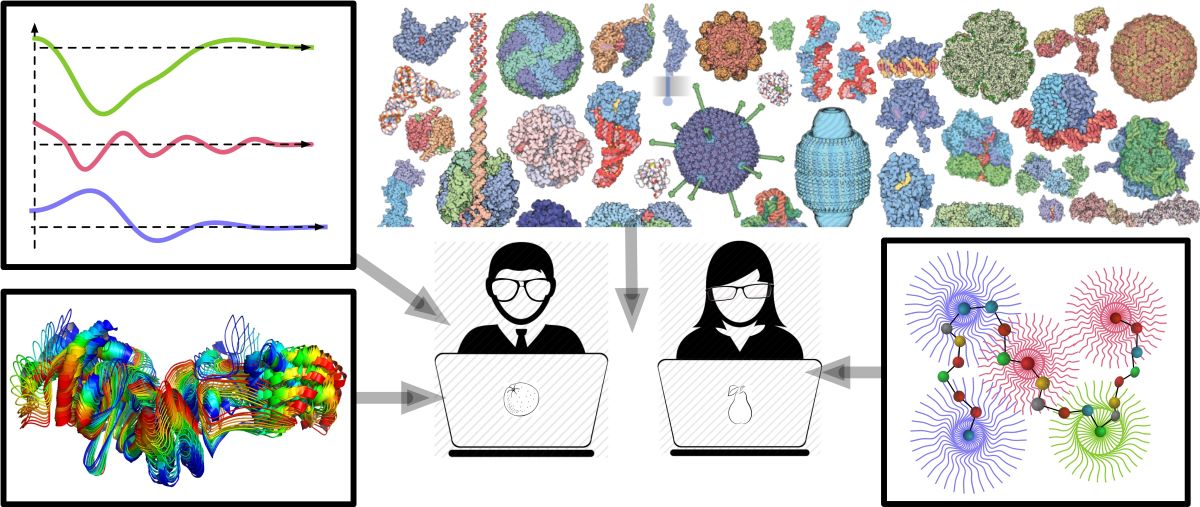Speaker
Description
We have participated, both as predictors and as scorers, in all proposed targets of the 8th CAPRI edition. Here we will focus on the 11 purely CAPRI targets, that is, excluding the CASP-CAPRI joint rounds 46, 50 and 54, already evaluated and discussed in the respective CASP meetings, and the 4 targets in round 51 related to COVID19, with no available structure for evaluation. These 11 targets involved domain-domain, protein-protein and protein-DNA interactions, with homo- and hetero-meric interfaces.
As predictors, in general, we applied our standard pyDock protocol, based on the generation of rigid-body docking orientations with FTDock 2.0 and ZDock 2.1, and the selection of models by pyDock 3.0 scoring function. Oligomerization states and other specific issues were carefully treated in a case-by-case basis, applying symmetry restraints in case of homo-dimeric interfaces, and combining docking with homology-based interfaces if templates were available. The multi-domain protein in T160 was built by combining homology modelling with Modeller and domain-domain docking with pyDockTET [1]. In T161 we introduced flexibility in the inter-domain orientations using Normal Mode Analysis with ProDy. Protein-DNA interfaces in T187 and T188 were built by our recent pyDockDNA method [2]. Starting in round 53, interacting subunits were routinely modelled by AlphaFold2. In the last round (targets T231-T234) we combined docking models with those generated by AlphaFold-Multimer (ColabFold versions 1-3), selected on the basis of AF model confidence (0.8 ipTM + 0.2 pTM) [3] and pyDock scores.
We also participated as predictors with our server pyDockWeb [4], using the automatic FTDock and pyDock pipeline with symmetry-based restraints when needed.
As scorers, we mostly used pyDock 3.0 to directly score the provided models, without further minimization, applying the same restraints and additional filters as in predictors.
According to the results so far, our top 5 submitted models were successful in 6 out of the 10 evaluated targets either as predictors or as scorers: T160, T163, T187, T188, T231, and T232. In addition, we got an acceptable model in T161, but had too many clashes. Especially interesting were the results for the protein-DNA interface in T188, where we were the only group with acceptable models as predictors (top 1) and as scorers (top 5). On the other side, the targets where we failed both as predictors and as scorers were actually challenging for all participants (e.g. no successful group in T187 protein-DNA interface or in T234; only one successful group as predictors in T161 and T162).
Overall, the performance of pyDock in this 8th CAPRI edition was in line with that of the best participants. This experiment has shown that the problem of protein-protein docking is far from being solved, and has confirmed the value of energy-based scoring and other approaches in combination with AlphaFold predictions.
[1] Cheng TM, Blundell TL, Fernandez-Recio J (2008) Structural assembly of two-domain proteins by rigid-body docking. BMC Bioinformatics 9:441.
[2] Rodríguez-Lumbreras LA, Jiménez-García B, Giménez-Santamarina S, Fernández-Recio J (2022) pyDockDNA: A new web server for energy-based protein-DNA docking and scoring. Front. Mol. Biosci. 9:988996.
[3] Evans R, O’Neill M, Pritzel A, et al. (2021) Protein complex prediction with AlphaFold-Multimer. BioRxiv.
[4] Jiménez-García B, Pons C, Fernández-Recio J (2013) pyDockWEB: A web server for rigid-body protein-protein docking using electrostatics and desolvation scoring. Bioinformatics, 29:1698-1699.
| Submitting to: | 8th CAPRI assessment meeting |
|---|

